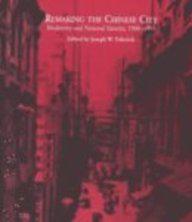
章节目录
List of Illustrations vii Preface ix Chapter 1 Modernity and Nation in the Chinese City 1 Joseph W. Esherick Part I: The Modernist City Chapter 2 Canton Remapped 19 Michael Tsin Chapter 3 Hygienic Modernity in Tianjin 30 Ruth Rogaski Chapter 4 Urban Identity and Urban Networks in Cosmopolitan Cities: Banks and Bankers in Tianjin, 1900–1937 47 Brett Sheehan Chapter 5 Railway City and National Capital: Two Faces of the Modern in Changchun 65 David D. Buck Chapter 6 Yang Sen in Chengdu: Urban Planning in the Interior 90 Kristin Stapleton Part II: Tradition and Modernity Chapter 7 Tourism and Spatial Change in Hangzhou, 1911–1927 107 Liping Wang Chapter 8 Defining Beiping: Urban Reconstruction and National Identity, 1928–1936 121 Madeleine Yue Dong Chapter 9 Building a Dream: Constructing a National Capital in Nanjing, 1927–1937 139 Charles D. Musgrove
内容简介
In China today skyscrapers tower over ancient temples, freeways deliver lines of cars and tour buses to imperial palaces, cinema houses compete with old theaters featuring Peking Opera. The disparity evidenced in the contemporary Chinese cityscape can be traced to the early decades of the twentieth century, when government elites sought to transform cities into a new world that would be at once modern and distinctly Chinese. Remaking the Chinese City aims to capture the full diversity of recent Chinese urbanism by examining the modernist transformations of China's cities in the first half of the twentieth century. Collecting in one place some of the most interesting and exciting new work on Chinese urban history, this volume presents thirteen essays discussing ten Chinese cities: the commercial and industrial center of Shanghai; the old capital, Beijing; the southern coastal city of Canton; the interior's Chengdu; the tourist city of Hangzhou; the utopian "New Capital" built in Manchuria during the Japanese occupation; the treaty port of Tianjin; the Nationalists' capital in Nanjing; and temporary wartime capitals of Wuhan and Chongqing. Unlike past treatments of early twentieth-century China, which characterize the period as one of failure and decay, the contributors to this volume describe an exciting world in constant and fundamental change. During this time, the Chinese city was remade to accommodate parks and police, paved roads and public spaces. Rickshaws, trolleys, and buses allowed the growth of new downtowns. Department stores, theaters, newspapers, and modern advertising nourished a new urban identity. Sanitary regulations and traffic laws were enforced, and modern media and transport permitted unprecedented freedoms. Yet despite their fondness for things Western and modern, early urban planners envisioned cities that would lead the Chinese nation and preserve Chinese tradition. The very desire for modernity led to the construction of a visible and accessible national past and the imagining of a distinctive national future. In their investigation of the national capitals of the period, the essays show how cities were reshaped to represent and serve the nation. To promote tourism, traditions were invented and recycled for the pleasure and edification of new middle-class and foreign consumers of culture. Abundantly illustrated with maps and photographs, Remaking the Chinese City presents the best and most current scholarship on modern Chinese cities. Its thoroughness and detailed scholarship will appeal to the specialist, while its clarity and scope will engage the general reader.
下载说明
1、Remaking the Chinese City是作者Joseph Esherick (Edi创作的原创作品,下载链接均为网友上传的网盘链接!
2、相识电子书提供优质免费的txt、pdf等下载链接,所有电子书均为完整版!
